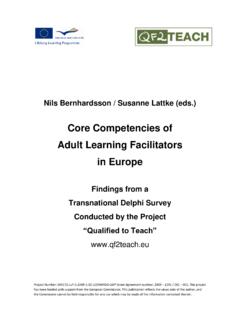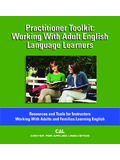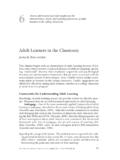Transcription of Facilitating Adult Learning - MSU Extension Organizational ...
1 1 Facilitating Adult Learning Prepared by: Dr. Lela Vandenberg Senior Leadership & Professional Development Specialist 11 Agriculture Hall East Lansing, MI 48824-1039 (517) 353-1898 How toTeach soPeopleLearn 2 Five Principles of Adult Learning It s one thing to teach. It s another thing to learn, and the two don t always go hand in hand. As educators, our job is to facilitate Learning , that is, to do what we can to make sure people learn what we want to teach them. Incorporating five basic principles in your program design can ensure that your learners really do learn.
2 These are based on years of research in Adult Learning . 1) Personal Benefit. Adult learners must be able to see the personal benefit of what they are Learning , and how it satisfies a need they have. They are motivated to learn if the Learning - Solves or avoids a problem for them; - Provides an opportunity or increased status; - Leads to professional or personal growth. 2) Experience. Adult learners come to each Learning event with a unique background of knowledge and experience. They are motivated to learn if the Learning - Involves them in sharing what they know; - Builds on what they know; - Validates their expertise.
3 3) Self Direction. Adult learners are self directed and must have some control over what they are Learning . They are motivated to learn if they can - Take charge of their Learning and make decisions about the content and process; - Contribute to the Learning of their co learners; - Have some degree of independence in the Learning process. 4) Application & Action. Adult learners are busy, practical, and learn by doing. They learn best when - There is immediate application for the Learning ; - They participate actively in the Learning process; - They can practice new skills or test new knowledge before leaving a Learning session.
4 5) Learning Styles. Adult learners approach Learning in a great variety of ways, from hands on and moving to using their eyes, ears, and/or logic to anchor new skills and knowledge. They learn best when - The Learning taps into a mix of Learning styles that fit their preferences and stimulate their multiple intelligences ; - Multiple means are used to represent the material being learned. Key references available in the Professional Development Library:Bowman, S. 2003. How to Give It so They Get It; Knowles, M. et al. 2005. The Adult Learner; Stolovitch, and Keeps, 2002.
5 Telling Ain t Training; Tamblyn, D. 2003. Laugh and Learn; Vella, J. 2002. Learning to Listen Learning to Teach; Wlodkowski, 3 Techniques for Facilitating Learning There are a number of powerful methods to help your learners retain what you teach. If you are lecturing, with or without PowerPoint, stop every 15 30 minutes and engage learners in an activity to reinforce Learning . For some topics, learners may already know some of what you ll teach, or have experience with it. Some of the activities suggested below involve having them brainstorm first, with you filling in the blanks in their knowledge afterwards.
6 These participatory methods focus on five participatory processes: reflecting, summarizing, sharing knowledge, teaching, and receiving feedback. Each of these is described below, with suggested Learning activities. A. REFLECT Learning is enhanced if we are given a chance to reflect, review, and personally relate to the material and how we might apply it. Give participants a log or journal, then use a variety of ways to have participants stop and reflect periodically for a few minutes on what they ve learned and how they might use it. After the reflection time you can have them volunteer to share, share in small groups, or not share.
7 Here are six examples: 1) Most Important: Write three things you just learned. Now put a star by the most important. 2) Three Applications: Write three ways you can use or apply what you ve just learned. Circle the one you plan to do first. 3) One Sentence: Write one sentence explaining what you learned in the last _____ minutes. 4) One Question: Write one question that you have about what you ve heard. 5) Wow / How About: On a sticky note, write a WOW something you learned that was important to you. On another sticky note, write a HOW ABOUT ?
8 Question or other idea you might have. Post your notes on the two flip charts (labeled WOW and HOW ABOUT). Build in some time to debrief the two charts. 6) Highlights: Spend the next four minutes reading and reviewing the notes and the other information in your packet. Highlight the important points. Write any questions you still have. B. SUMMARIZE Having learners summarize, in a sentence or two, the most important things they have just learned is another powerful way to have them interact with the content and fix it in their minds. Here are 7 fun ways they can share their summaries with others.
9 1) Best Summaries: On an index card, each participant prepares a summary of the main points at the end of a segment or topic. On the other side of the card have them put a code or 4identifying PIN. Teams of 4 7 collect their cards and exchange them with another team. Then each team selects the best summary from the set of cards they were given. Each team reads the summary to the whole group. Also read the identifying PIN so the author can be congratulated. 2) Essence: Explain this activity at the beginning of a presentation to spark a competitive spirit and motivate participants to pay close attention.
10 Following the presentation, divide the group into teams of 3 7. There are four rounds. 1 Tell them to create a 32 word summary of what they have learned. Have each group read their summary, then participants vote for the best by raising their hands. There are two rules: they can only vote once, and they can t vote for their own team s summary. 2 Repeat the process but now the summary must be only 16 words. 3 Repeat the process for an 8 word summary. 4 Repeat the process for a 4 word summary. 5 Repeat the process for a 2 word summary. 3) Superlatives: After a presentation, ask participants to identify the most important piece of information or concept that you presented.









